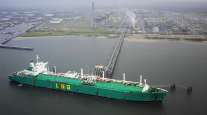Shipping Costs for Liquefied Natural Gas Expected to Rise

Liquefied natural gas shipping costs will increase, driven by rising charter rates, higher fuel costs and the growth in interbasin trade flows, according to estimations by Fitch Solutions Macro Research.
“From 2019, the increase in tanker capacity looks set to lag the growth in demand. Industry projections show a mounting capacity deficit over the next five years, with a global deficit in LNG carriers in the range of 50 to 60 vessels forecast for 2022,” the report obtained by Trend said.
The shipping sector is highly cyclical, and a structural deficit and accompanying rise in charter rates will incentivize investment in newbuild capacity, according to the company.
“Due to the relatively long lead times involved [typically ranging from two to five years ], this capacity will not hit the market until the early to mid-2020s. In the interim, charter rates will roam higher as demand increasingly outstrips supply,” the report said.
Fitch Solutions says that besides rising charter rates, higher fuel prices and interbasin trade growth will combine to drive shipping costs higher over the coming years.
“The type and amount of fuel demanded depends on the type of LNG carriers used. Older, steam turbine vessels are less efficient, have higher LNG boil-off rates and are more reliant on liquid fuels. Adding to generally higher oil prices, the implementation of the International Maritime Organization’s sulphur cap in 2020 will further inflate shipping costs,” the report said.
LNG tankers which rely on high-sulphur fuel oil will have to switch to low-sulphur fuel oil or gas oil to comply with the new regulations, Fitch Solutions says.
Another factor influencing shipping costs will be the change in trade flows, according to the report.
“With demand growth heavily concentrated in Asia-Pacific and supply growth shifting to North America, we forecast growing regional imbalances in the global LNG market. Our data indicate that Asia-Pacific will contribute over two thirds of global demand growth over the next five years, but provide little more than 10% of the growth in supply. An increasing number of cargoes will have to be pulled from the Atlantic-to-Pacific basin, in order to offset this imbalance,” the company said.
Distributed by Tribune Content Agency LLC
Distributed by Tribune Content Agency, LLC




